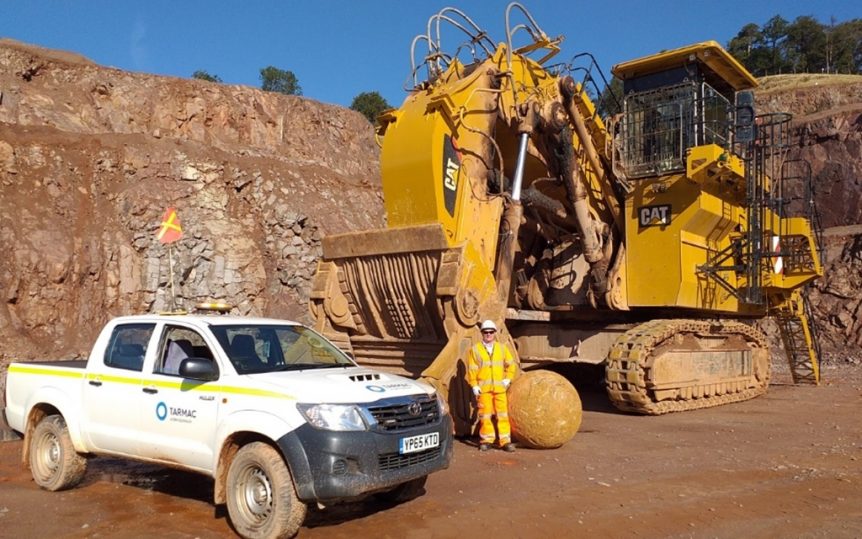We previously explained how the quarry team has moved forward by developing environmental monitoring and biodiversity programmes. This month, quarry operations manager Shane Tompkin and Engineering Manager Graham Darch, describe some of the operational and engineering changes over recent times.
The Mountsorrel operating equipment was generally installed between the late 1960s – early ‘70s. It was designed and planned so well, that most of it is still operational today. The continuous improvement programmes mean operational quality, standards and human resources have all been upgraded to meet or exceed the requirements of current health and safety, human resources and environmental standards. This article touches briefly on some of the key changes over the last few years.
Shane oversees the continuous improvement programme, which benefits the local environment, the local community, customer needs and site staff.
He says; “We need to make sure we extract and use the stone in the most efficient way, as we can only use it once.
“We are already going as deep as possible, 190m below sea level, in the existing working area and are now preparing to move into the next area for which we already have planning permission, further to the east and south.”
This means:
- The new, big stone crusher will be within the quarry, to access the stone currently under the existing crusher. This will help to improve air quality.
- Main activities will be below the quarry rim
- The surge pile (the feed to the secondary crusher from the main conveyor) will be covered, to help reduce noise
- Dump truck numbers will be reduced, reflecting a shorter haul from the rock face to the crusher.
For Shane, looking after the workforce is as important to him and his team as the operations.
“We encourage full team participation in the design and management of safe working procedures. No task is so important it cannot be done safely, and each workforce section is represented on the Safety Committee.
“We are also at the leading edge of monitoring behavioural changes, mental awareness and the physical health of all our employees. The ‘Mates in Mind’ programme is specifically designed to track our staff’s mental welfare”.
While Shane ensures the production team meets its market requirements, Engineering Manager Graham Darch makes sure all the vital fixed and mobile plant and equipment is maintained, so it can produce materials as and when required.
Over the last year, Graham has increased the Engineering team from 29 – 66 full-time employees. External sub-contractors have been replaced by Tarmac technicians, mostly living within 10 – 15 miles of the site. The team supports the site 24 hours, 7 days a week and delivers a planned maintenance programme during the night shifts and weekends.
The team covers the railhead, the two asphalt plants and all the processing activities (the crushers, conveyors, chutes, motors, gearboxes and mobile plant) including the fleet of 17 x 100 tonne capacity trucks.
Graham believes the new structure and processes are making a real difference.
“We continue to invest in training and developing our people, creating flexibility across the department, as we aim to become an Engineering Centre of Excellence. Using only in-house staff means we can offer more full time, well paid, skilled and unskilled jobs to the local community.
“People are at the very front of the engineering function with changes in working culture and practices, a better canteen and greater flexibility across the department. These are reflected in opportunities for enhanced safety, work/life balance and long-term careers.”
Ongoing reviews reflect the ever-changing needs of the operations team and a focus on the people who work on site. Examples include:
- Relocating the offices to land west of Bond Lane, so they are completely separated from the heavy plant workshops and the big vehicles using the entrance on the other side of the road. This maximises health and safety for all employees
- A new rinsing plant provides a secondary wash for the ballast (reducing dust levels as materials are loaded into the rail wagons at the railhead) and onward to the customer.
Did you know:
- The biggest single quarry blast was 42,000 tonnes
- The current primary crusher is about 92m above sea level. The new crusher will be 60m lower and below the quarry rim
- The original dump trucks carried 25 tonnes of stone. The new vehicles can transport 100 tonnes at a time, reducing vehicle movements
- 30% of the quarry production is used as egg-sized railway ballast, delivered by rail to railway tracks all over the country
- Asphalt for road surfacing now includes up to 30% recycled material
- The haul road down to the bottom of the quarry is now 3000 metres long compared to 1500 metres in 2012
- The quarry produces 11 different sizes of stone.
- HM Government has thanked Mountsorrel Quarry staff for keeping production going during this difficult time. It recognised the role the quarry team plays in keeping the road network open by supplying asphalt to Highways England
- At the same time, 8 to 10,000 tonnes a week of railway ballast is supplied to Network Rail to keep trains running. 70% of this is delivered directly by rail, reducing the number of heavy vehicles on the road
- The remaining quarry staff are focussed on efficiently and safely producing these vital materials and are considered as key workers by the Government
